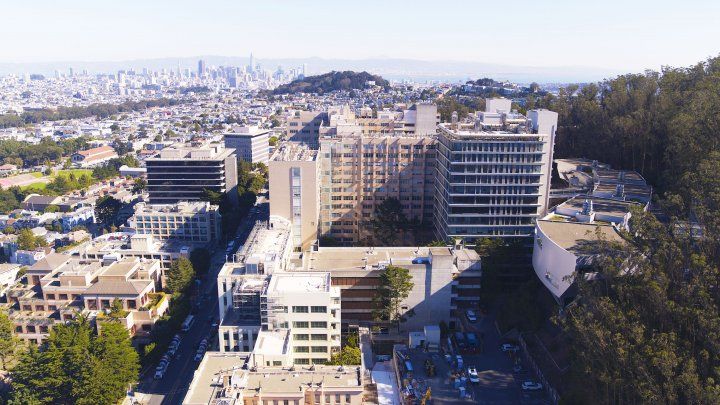UCSF Selects Design Team for Parnassus Research and Academic Building

In a promising pairing of science and art, UC San Francisco – one of the world’s premier health science universities – has hired two renowned firms, HGA and Snøhetta, to design a new Research and Academic Building on its Parnassus Heights campus.
The Parnassus Research and Academic Building, known for now as the PRAB, will anchor the west end of the campus, which has been UCSF’s home for more than a century. A comprehensive planning process is under way for a major renovation and expansion of the campus over the next decade, including a new hospital at the eastern end of Parnassus Avenue.
HGA and Snøhetta submitted a joint proposal, and UCSF – an institution known for teamwork between its scientists, clinicians and educators – particularly admired the collaborative nature of their proposal. UCSF said 17 firms responded to its request for proposals, and all were excellent. The University initially chose four finalists, and a team led by Chancellor Sam Hawgood, MBBS, selected HGA and Snøhetta from that list.
“These cutting-edge firms were willing to join us in thinking outside of the box to face the unique opportunities that we see in this critical phase of the Parnassus plan,” said Daniel Lowenstein, MD, UCSF’s executive vice chancellor and provost. “In particular, they bring new ways of fostering collaboration, an openness to our relationship to the local community, and a robust and productive connectivity with the rest of the campus.”
Both firms bring impressive pedigrees. HGA, which will serve as the executive architect and architect of record, is a national interdisciplinary design firm founded in Minnesota whose projects have included art museums, corporate headquarters, sports stadiums, and hospitals and research centers for the Mayo Clinic, UC Davis, Stanford University and others. Snøhetta – named for one of Norway’s highest mountains – integrates architectural, landscape, interior, product, graphic, digital design and art across its projects, which include the new library of Alexandria, Egypt, the National September 11 Memorial Museum Pavilion in New York City, and the 2016 expansion of the San Francisco Museum of Modern Art.
HGA will lead programming, planning, and project management, as well as the design of research lab and technical program spaces. Snøhetta will lead the overall conceptual design for the building and surrounding public realm, including landscape and site improvements.
Both firms will work with a wide-ranging, interdisciplinary design-build team from UCSF in an integrated design and construction center to support collaboration, public engagement, and the development of a holistic design.
“The HGA and Snøhetta team embody traits that are not just important for a successful design partnership, but also represent our aspirations for the PRAB project, including collaboration, creativity, innovation and excellence,” said Brian Newman, senior associate vice chancellor, UCSF Real Estate, and vice president, UCSF Health. “The two firms see the project site and its topographical challenges as opportunities to open up the interior of the campus and facilitate movement from the PRAB to other buildings.”
Breaking up the silos that once defined scientific research, UCSF creates spaces where a cell biologist might cross paths with an immunologist, leading to a collaboration that could create a new approach to treating a deadly disease.
“It is a remarkable time for scientific breakthroughs where new methods and technologies can lead to exceptional results,” said Chris Martin, principal and science and technology market sector leader at HGA. “We are excited to work with Snøhetta, other local partners, and UCSF to create a forward-looking research and academic setting to advance human health outcomes.”
“The PRAB project will not only serve clinicians and researchers at UCSF, but it will also take advantage of San Francisco’s climate and natural context,” said Michelle Delk, partner and landscape architect at Snøhetta. “Through a truly collaborative design partnership, we will help UCSF reimagine this site and the future of the Parnassus Heights campus,” said Alan Gordon, partner and architect at Snøhetta.
Patti Mitchell, UCSF’s director of Campus Design and Construction for the west zone, and deputy campus architect, said the winning team had a particularly people-minded approach. “They had innovative ideas about how people would interact when they were in the building,” Mitchell said. “Their proposal was more human-centric versus others that were more building-focused.”
Mitchell said UCSF will work with HGA and Snøhetta to select a design builder, and that firm will serve as the general contractor, with the designers integrated under that contract, along with an array of trade partners. The estimated $700 million project will include the building, as well as improvements to Parnassus Avenue, extending Fourth Avenue, creating a new promenade and loading dock, the demolition of UC Hall, and the initial components of an “energy center” that will ensure UCSF can install new infrastructure when energy technology changes down the road. The PRAB is expected to open in 2026.